I'd guess osrmIsochrone has changed since, another indicator is the use of deprecated returnclass argument. When using map() like that, it cycles through every element of geometry and osrmIsochrone() receives a sfg POINT:
> str(major_trauma_centres$geometry[[1]])
'XY' num [1:2] 0.139 52.174
> class(major_trauma_centres$geometry[[1]])
[1] "XY" "POINT" "sfg"
And it will fail during inherits() checks.
While map() can be used, perhaps consider a rowwise aproach with nested tibbles instead. We'll first nest the geometry column to create 1 sf object per row, those can be passed directly to osrmIsochrone() when we have changed grouping to row-wise:
library(dplyr)
library(tidyr)
library(sf)
library(osrm)
library(mapview)
# 2 first features from linked sample:
geojson <-
r"(
{
"type": "FeatureCollection",
"name": "major_trauma_centres",
"crs": { "type": "name", "properties": { "name": "urn:ogc:def:crs:OGC:1.3:CRS84" } },
"features": [
{ "type": "Feature", "properties": { "name": "ADDENBROOKE'S HOSPITAL", "org_id": "RGT01" },
"geometry": { "type": "Point", "coordinates": [ 0.139114480160586, 52.173740681989244 ] }
},
{ "type": "Feature", "properties": { "name": "DERRIFORD HOSPITAL", "org_id": "RK950" },
"geometry": { "type": "Point", "coordinates": [ -4.113684475426827, 50.416719948823165 ] }
}]
}
)"
major_trauma_centres <- read_sf(geojson)
major_trauma_centres
#> Simple feature collection with 2 features and 2 fields
#> Geometry type: POINT
#> Dimension: XY
#> Bounding box: xmin: -4.113684 ymin: 50.41672 xmax: 0.1391145 ymax: 52.17374
#> Geodetic CRS: WGS 84
#> # A tibble: 2 × 3
#> name org_id geometry
#> <chr> <chr> <POINT [°]>
#> 1 ADDENBROOKE'S HOSPITAL RGT01 (0.1391145 52.17374)
#> 2 DERRIFORD HOSPITAL RK950 (-4.113684 50.41672)
mtc_iso <- major_trauma_centres %>%
nest(sf = geometry) %>%
rowwise() %>%
# # A tibble: 2 × 3
# # Rowwise:
# name org_id sf
# <chr> <chr> <list>
# 1 ADDENBROOKE'S HOSPITAL RGT01 <sf [1 × 1]>
# 2 DERRIFORD HOSPITAL RK950 <sf [1 × 1]>
mutate(sf = list(osrmIsochrone(sf, breaks = seq(0, 150, by = 30)))) %>%
# # A tibble: 2 × 3
# # Rowwise:
# name org_id sf
# <chr> <chr> <list>
# 1 ADDENBROOKE'S HOSPITAL RGT01 <sf [5 × 4]>
# 2 DERRIFORD HOSPITAL RK950 <sf [5 × 4]>
unnest(sf) %>%
# # A tibble: 10 × 6
# name org_id id isomin isomax geometry
# <chr> <chr> <int> <dbl> <dbl> <MULTIPOLYGON [°]>
# 1 ADDENBROOKE'S HOSPITAL RGT01 1 0 30 (((-0.1396775 52.29685, -0.1948542 52.23069, -0.1619805 52.11…
# 2 ADDENBROOKE'S HOSPITAL RGT01 2 30 60 (((0.4178975 52.66022, 0.2320392 52.61955, 0.06204679 52.5708…
# .. ...
st_sf() %>%
st_transform(crs = 27700)
mtc_iso
#> Simple feature collection with 10 features and 5 fields
#> Geometry type: MULTIPOLYGON
#> Dimension: XY
#> Bounding box: xmin: 122723 ymin: 2911.149 xmax: 665720.2 ymax: 413292.3
#> Projected CRS: OSGB36 / British National Grid
#> # A tibble: 10 × 6
#> name org_id id isomin isomax geometry
#> * <chr> <chr> <int> <dbl> <dbl> <MULTIPOLYGON [m]>
#> 1 ADDENBROOKE'S HOSPITAL RGT01 1 0 30 (((526960.8 268154.6, 5233…
#> 2 ADDENBROOKE'S HOSPITAL RGT01 2 30 60 (((563626.1 309688.1, 5511…
#> 3 ADDENBROOKE'S HOSPITAL RGT01 3 60 90 (((562689.8 337536.3, 5618…
#> 4 ADDENBROOKE'S HOSPITAL RGT01 4 90 120 (((487023.5 373144.4, 4745…
#> 5 ADDENBROOKE'S HOSPITAL RGT01 5 120 150 (((461692.4 413292.3, 4576…
#> 6 DERRIFORD HOSPITAL RK950 1 0 30 (((256930.5 74023.6, 24695…
#> 7 DERRIFORD HOSPITAL RK950 2 30 60 (((257811 106269.7, 254748…
#> 8 DERRIFORD HOSPITAL RK950 3 60 90 (((323479.7 120954, 310482…
#> 9 DERRIFORD HOSPITAL RK950 4 90 120 (((322451.3 155866.8, 3108…
#> 10 DERRIFORD HOSPITAL RK950 5 120 150 (((363210.5 201731, 350329…
mapview(mtc_iso, z = "id")

Created on 2023-06-30 with reprex v2.0.2
For map(), something like this would work:
major_trauma_centres %>%
mutate(iso = map(geometry, \(pnt) unclass(pnt) %>% osrmIsochrone(breaks = seq(0, 150, by = 30))))
This will pass each POINT feature though unclass() first and osrmIsochrone() will receive a vector of coordinates, one of the acceptable formats for loc argument.
